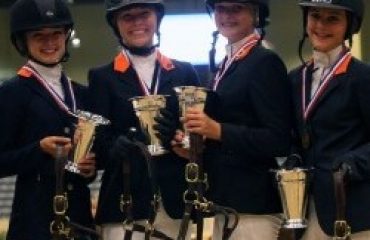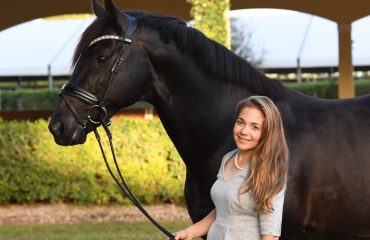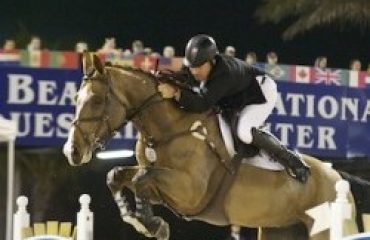
Boyd Martin riding Gloria Callen’s mare Welcome Shadow
Photo by Amber Heintzberger
Well known for both his fun-loving approach to life and his indefatigable work ethic, Boyd Martin has represented the U.S.A. in three-day eventing at two Olympic Games and two World Championships, and was on the gold medal-winning Pan Am Games team in 2015. Boyd’s wife, Silva Martin, is a grand prix dressage rider and they have a son, Nox. Boyd and Silva train out of their own farm, Windurra USA in Cochranville, Pennsylvania, and spend winters at Stable View Farm in Aiken, South Carolina.
If you weren’t an eventer what path would you have chosen?
I always joke that if I weren’t into horses I probably would end up a professional gambler. I wasn’t cut out for life behind a desk, and I love the adrenaline rush of a good cross-country run, and the satisfaction of placing well at a big event. But running a farm, training horses and teaching lessons, and now being a parent, also give life meaning. At the end of a long day of work, a barn full of healthy, happy horses on a well-maintained farm and time with my family are very rewarding. In the end I’m obviously competitive by nature and I’m driven to succeed; I work hard to be a successful member of the U.S. Eventing Team and I can’t imagine doing anything else.
What is a typical training day at Windurra?
Silva and I are up early and have a quick breakfast with Nox before we head to the barns. We live on our farm, so the commute is easy! The great part about this, since becoming parents, is that we’re able to spend a lot of time together as a family — even when we’re working Nox is a part of every day at the farm. With the hectic work schedule of running a farm and competing on weekends, I work seven days a week and very rarely get a day off.
Everyone meets at the barn at 7 a.m. My working students and grooms feed and muck out so I can be on my first horse around 7:30 in the morning. I start with the upper-level horses and work my way down the list; I may have an assistant ride a horse, often hacking them out for 40 minutes or so — 45 minutes of walking or 20 minutes of trotting on the track, to keep them moving and fit — before I get on and do their dressage or jump training. Each horse is under saddle for about an hour and a half every day. Silva helps me with their dressage schooling as well, both riding my horses and giving me pointers while I ride them. We do a lot of multitasking around here — Silva and I might keep an eye on each other and our riders and offer advice with different horses throughout the day. Most of the teaching that I do is for the riders working for me, though I also travel to teach clinics.
It’s true that “If you build it, they will come.” Trainers bring students to our farm to use our rings and galloping track with Attwood Equestrian Surfaces footing and to school our cross-country course, built by ETB Construction and featuring jumps from the tiniest logs on the ground up to the types of questions you’d see at a four-star: a sunken road, water complex and so on.
Thanks to the thrills and spills of the riding life, Silva and I also work with personal trainer Linda Brown to stay fit and strong in the saddle. Linda puts us through some core exercises once or twice a week, Monday and/or Thursday, to keep us fighting fit.
With owners, syndicate members and sponsors to keep happy, I also spend time doing video updates, working out training plans for the horses, or doing an interview or photo shoot for a product or magazine. Every day brings something new.
For all the guys and girls who work for me, the day never really stops. They basically eat lunch on the run. I have two guys working full time whose sole duty is grooming horses: all day they spend time brushing, wrapping legs and going over them head to toe. Another groom and some working students tack up, wash horses down and do turnout, and I’ve got a couple assistant riders who warm horses up and cool them down for me.
Do you prefer bringing along young horses or riding made horses, and why?
I do everything: I think the key to success is to not have one set system. I’m obsessed with really top class horses and I don’t care if they’re 3 or 13 years old. I’ve had a fair bit of success over the years buying a going horse, but really my core group of horses have been produced from young horses. We usually buy around four young horses every year to produce and I enjoy playing around with the baby horses at the end of the day with my enthusiastic young working riders. It’s a great sense of achievement when you have a young horse and see it all the way through to the four-star.
Each scenario has its pros and cons, and while it can be very exciting to get on a made horse that already knows its job, it is also rewarding to bring a horse up the levels. I’ve taken horses off the track as well as produced horses that we bred in Australia, and there’s nothing like winning a big event on a horse that you produced yourself. Of course, there’s always the risk with an unproven horse that they won’t make it up the levels, and I’ve had a number of horses that lacked either the talent or the stamina to make it as world-class competitors. If time is on your side, bringing along a young horse is a lot of fun, and can also be a good way to make a profit if you have some success with a horse and then sell them on to the next rider.
A couple of my top horses already had experience at the upper levels. One benefit of buying a made horse is that you can be competitive at a higher level within a shorter amount of time — but you need purchasing power for this option. The Blackfoot Mystery Syndicate got behind Big Red in 2015, strategically planning to make the team for the 2016 Olympic Games in Rio de Janeiro. Red had competed to the three-star level with Kelly Prather, and it was relatively easy to get him going at the four-star level. Though he was a bit green as a four-star horse, he was the second-top finishing U.S. Eventing Team horse at the 2016 Olympic Games.
Shamwari had already competed at the Olympic Games in London in 2012 with Swedish rider Ludwig Svennerstal. But even though he was a world-class competitor, it took quite a while for me to puzzle out how to ride him. With time and training, Shammie and I developed an excellent partnership and finished seventh at the World Equestrian Games in 2014. But while purchasing a made horse — even an Olympian — can be a huge advantage, it is not a guaranteed path to success.













